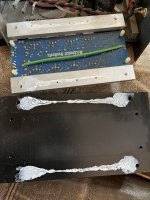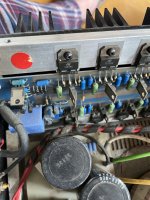Yeah..... saw that too when looking closer, and edited my post.All outputs look like they are cut off but I think this is original. These BD's have pretty short legs making it impossible to bend them and reach the solderside.
Last edited:
Jeez........ Need to go clean my glasses............I see TIP36C, not TIP35C. 😉
In a moment..... Have some editing to do here. 😆
Thanks @Netlist ........ About time for a bigger screen now.
Is the cracking sound present only during startup or all the time when listening?the right mono is what I would consider a normal pop but the left mono sounds pretty bad , like a proper cracking sound .
Replacing the small caps has resolved the issue, just about to recap the other one .The 4 TIP36C output transistors are originals. The 4 BD249C are replacements put instead of TIP35C on a previous rep.
If this is the "bad" channel, whoever did this rep., probably missed some bad component/solder joint too.
Looking at photos of other genesis monoblocks online the transistors are all the same as mine ( soldered legs ) so yes I think you are correct in that the manufacturers did this to extend the legs .All outputs look like they are cut off but I think this is original. These BD's have pretty short legs making it impossible to bend them and reach the solderside.
Complement of output transistors BD249 is BD250, or for TIP36 that would be TIP35. Both could be original, but normally a manufacturer would stick to one of the pairs. That's all I can see. 🙂
I wouldn't worry about these output transistors for now but focus on the crackling channel.
Hugo
The left mono is identical too .
Only upon start up , replacing the small caps has fixed the issue.Is the cracking sound present only during startup or all the time when listening?
These amps sound wonderful so worth any effort imo .
Way to go, man........... Great job 👍Replacing the small caps has resolved the issue, just about to recap the other one .
Remember to post about the channel imbalance afterwords.
And be sure, the imbalance doesn´t come from the preamp (easy to swap channels to check) 😉
Check, if the left mono has identical BD249´s as the right one.The left mono is identical too .
If so, the manufacturer at the time could have had trouble in sourcing TIP35 and went for BD249 instead.
Nothing to worry about. They are identical.
Wow........ They really saved a few pennies there.Photo showing the dried thermal paste
Be more generous when replacing that paste 👍
Yes, that's not how it should be done. You can see that the metal has only made contact on the sides.
Make sure both surfaces are as clean and smooth as possible, especially around the drilled holes.
I would even drill a third hole in the center, somewhere between two transistors, to fit a third screw, if you have the tools.
Make sure both surfaces are as clean and smooth as possible, especially around the drilled holes.
I would even drill a third hole in the center, somewhere between two transistors, to fit a third screw, if you have the tools.
If you can get graphite sheets, these are the very best for this application:
https://nl.farnell.com/intelligent-...0-2a/heat-sink-pads-graphite-sheet/dp/3702712
But you need to keep the isolators between the transistors and heatsink.
https://nl.farnell.com/intelligent-...0-2a/heat-sink-pads-graphite-sheet/dp/3702712
But you need to keep the isolators between the transistors and heatsink.
I see and agree with what you’re saying trouble is the fins of the heatsink are bang in the middle which as an alternative would mean 2 screws either side of the fins which then means 4 screws ( top and bottom) so probably a cost cutting exercise.Yes, that's not how it should be done. You can see that the metal has only made contact on the sides.
Make sure both surfaces are as clean and smooth as possible, especially around the drilled holes.
I would even drill a third hole in the center, somewhere between two transistors, to fit a third screw, if you have the tools.
Great, if you don't notice a huge difference in temperature between the heatsinks and the alu block, all will be fine.
Well done!
Well done!
Good point , I will give them a few hours to heat up then test the temperature differences . Cheers
I’m fully aware that the subject of replacing capacitors draws many a heated discussion ( surely this repair/result proves it ) but should I now replace the power supply caps too ? Though I must say that in my humble experience it’s usually the little caps that go bad .
- Home
- Amplifiers
- Solid State
- Bad pop/cracking sound when powering on

